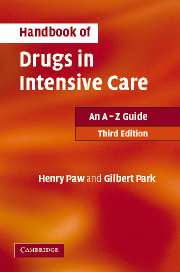Introduction
Published online by Cambridge University Press: 06 December 2010
Summary
The main challenge when I embarked in writing the third edition has been to keep it down to size. This third edition remains a concise book that explains how to use drugs safely and effectively in a critical care setting. Doctors, nurses and other professionals caring for the critically ill patient will find it useful. It is intended to be small enough to fit in the pocket and to provide sufficient information about drug prescribing in the critically ill patient. To keep the book down to size has meant restricting the list of drugs to ones that I consider as common drugs. It is not intended to list every conceivable complication and problem that can occur with a drug but to concentrate on those the clinician is likely to encounter. These constraints mean that this pocket book should be seen as complementary to, rather than replacing, the standard textbooks.
The book is composed of two main sections. The A-Z guide is the major part and is arranged alphabetically by the non-proprietary name of the drug. This format has made it easier for the user to find a particular drug when in a hurry. The discussion on an individual drug is restricted to its use in the critically ill adult patient. The second part is comprised of short notes on relevant intensive care topics.
While every effort has been made to check drug dosages based on a 70 kg adult and information about every drug, it is still possible that errors may have crept in. I would therefore ask readers to check the information if it seems incorrect.
- Type
- Chapter
- Information
- Handbook of Drugs in Intensive CareAn A - Z Guide, pp. viiPublisher: Cambridge University PressPrint publication year: 2007



